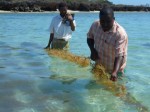Seaweed Farming
 Seaweed is an important component of the marine ecosystem along with the mangrove and coral reefs and can be viewed in two perspectives, from its ecological value as well as its economic uses.
Seaweed is an important component of the marine ecosystem along with the mangrove and coral reefs and can be viewed in two perspectives, from its ecological value as well as its economic uses.
Seaweed farming used to be an alternative livelihood in some villages along the Mtawara coast areas. In Tanzania context, seaweed is now emerging to be an important and major livelihood in the coastal areas, especially in the Zanzbar, Tanga, Kilwa, Lindi as well as now in Mtwara.
Environmentally, Seaweed farming helps to preserve coral reefs,by increasing diversity where the algae and seaweed have been introduced and it also provides added niche for local species of fish and invertebrates. Farming may be beneficial by increasing the production of herbivorous fishes and shellfish in the area.
Seaweed culture can also be used to capture, absorb, and eventually incorporate excessive nutrients into living tissue. "Nutrient bioextraction" is the preferred term for bioremediation involving cultured plants and animals. Nutrient bioextraction (also called bioharvesting) is the practice of farming and harvesting shellfish and seaweed for the purpose of removing nitrogen and other nutrients from natural water bodies.
On understanding these benefits, KIMWAM in collaboration with Seacology is committed to work in supporting local commuinty seaweed growers in Mtwara to insure the sector contributes not only to economical growth but also environmentally. Above images shows KIMWAM Officers inspecting Seaweeding faming at Mkungu Village.
International Coorperation and partnership

International Coorperation and partnership is one of the key issues in KIMWAM's activities. On the picture above (The first Black man from the left) is one of the KIMWAM's staffs (Samli Hassani) possed for the picture at the conference "International Conference on Fisheries and Globalization) held in Iloilo Phillipines, Sept 2012.
Women Empowerment

The MAMASAMKI Group (Women Fish Mongers) supported with Fish Cooling Container, posed for a picture when the Danish Society for Living Sea Chairman (Mr. Knud undersen) was handing over the container instalation activities to the KIMWAM and Women.
Here down, is Solar system for Fish Cooling Container, installed for for MAMASAKI Group. The project is funded by Danish Society for Living Sea with intention to support Poor Women Fish Mongers in Mtwara district. While on right handside are the Group members and a secretary taking a note of the meeting held at Ferry area in Mtwara.


The outlook of the Community Resource Centre built at Mtandi Village in Msimbati area. The project was funded by Seacology with purpose of awareness raising to the community on Marine Resources Management issues, Community development as well as Environmental Conservation information to the local community.
WOMEN ON FISHING
 Women are very important in development of small scale fishing industry. Regardless of their social responsibility to serve families, they are taken part as fish vendors to the local market in town and to the inland Districts. However, the women are also faced with inadequate accessibility to the financial resources and post harvesting handling technology as stated above.
Women are very important in development of small scale fishing industry. Regardless of their social responsibility to serve families, they are taken part as fish vendors to the local market in town and to the inland Districts. However, the women are also faced with inadequate accessibility to the financial resources and post harvesting handling technology as stated above.
Although there are some few women groups which are directly engaging in fishing anchors at sea shore, this activity is considered unacceptable due to the use of mosquito nets which collect juvenile fish. As a result it has never received any attention from government and development supporters. While some fishers in the Mnazi Bay Ruvuma Estuary Marine Park (MBREMP) area claimed to have received some support from authority the women groups have never given any attention.
Therefore, KIMWAM has planned for the forthcoming program the efforts to be made should consider improving women activities in fishing. This should include improvement of processing technology and storage capacity which will go hand by hand with improvement of their capacity to exploit available markets at inland Districts.
**KIMWAM is therefore, calling for stakeholders, donors, partners and other important actors on women empowerment for joining these efforts for supporting women**
MANGROVES DEGRATION IN MTWARA DISTRICT.
For centuries, peoples inhabiting the area have used mangrove for firewood and building material. Since the population was low in the past and migration was limited, it is likely that most human uses of the mangroves resources were sustainable. However, human population within the area has increased in the past decade and pressure and demand for mangrove products has increased correspondingly. Mangrove forests are currently harvested for firewood, charcoal, building materials and boat making.
KIMWAM in collaboration with Naliendele agricutural Reserch Institute had conducted Physical Survey for Identifying and demarkating highly degraded areas of mangrove forests around the Islands of Namponda, membelwa and Kisiwakidogo; the area surounded by Sinde, mkubiru, mnete, Nalingu and Mtandi Villages in Mnazi Bay Ruvuma Estuary Marine Park (MBREMP). The activity took place on September to October 2012 and was funded by SEACOLOGY.
Objective of this assignment was identification, mapping and demarcation of highly degraded areas for rehabilitation. About 257.803 hectares were demarcated as highly degraded areas that need mangroves replanting.
**KIMWAM is therefore, calling for stakeholders, donors, partners and other important actors to support mangroves planting campaign currently started for protection marine and terrestrial endangered species of the area.**

MAFAO theatre group performing to encourage community fight against new HIV infection and stigmatization.

